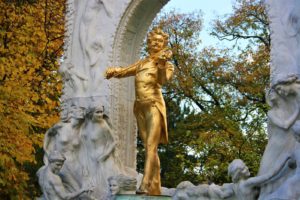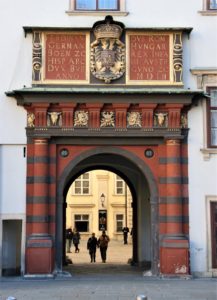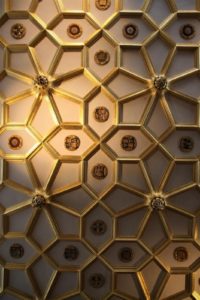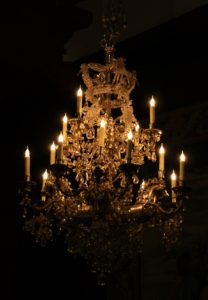This global downtime has given me much time to myself, to ponder, reflect and reminisce. The future of the world looks uncertain, however, I can take stock and be grateful for the memories I have already created and hope that one day soon I will be able to create many more. A visit to Vienna was one of the trips made and should have been one of my first blogs. Sorry. Time allows me to resurrect the photographic memories (both electronic and hard copies) from which I draw upon to write this blog. Five and half years later I’m finally putting pen to paper (or fingers to the keyboard) and composing my thoughts on my meanderings to the Austrian capital.

Vienna had only become a capital again when Austria regained its sovereign independence from allied control (another part of the history of this world that needs further exploration). Vienna’s interesting history shows that it has had its fair share of challenges, from the very start of its existence, surviving sieges and capture, to a city of palaces and society that entertained many. Like so many European cities its intriguing history is what inspires you to visit today.

What had lured me to this city I know not. Looking back, it was probably a combination of being given a number of travel guides and finding a cheap flight and the need to use up my remaining annual leave entitlement. Whatever it was that brought me here I can only be thankful as I left amazed at Vienna’s beauty. I waltzed around the streets of Vienna, uplifted by the glorious winter sunshine, and followed in the footsteps of illustrious musicians and royalty. The city boasts an abundance of architecture. Baroque buildings combine with several imperial palaces. Dotted around are museums and statues of iconic people associated with the city and mainly connected by the Ringstrasse.

In my recent meanderings around England (York, Chester) I’ve discovered how the Roman Empire expanded (and ultimately declined). I’ve learnt that the Romans had a good eye for setting up their outposts/forts. Vienna was slightly different as it was established by the Romans and called Vindobona. They may have got this one outpost slightly wrong as by the 5th century the barbarian invasions had reduced it to ruins. Its apparent weakness was its location on the edge of the Hungarian plains, but surely a strength was the mighty river that flowed nearby, the river Danube. This waterway must surely have been part of the success of the city as it evolved into a major trading centre by the 13th century. Vienna, however, knew its ups and downs. The same can be said for much of Europe. In the year 1683 it had finally defeated the Turks, and this is when the city really began to flourish, and it was that part of the city that I discovered and admired. The Hapsburgs ruled this imperial capital and developed it on the grandest scale. This brought with it much wealth to Vienna and its music began to thrive. Now known as the music capital of the world, its classical tastes are a far cry from the modern beats, inappropriate language and distasteful subjects. Europe looks to be reorganising itself once again due to Brexit and coronavirus. Clearly it has been here before. In the year 1814 the European powers that had defeated the Emperor Napoleon Bonaparte met for the year to discuss how to restore the established order which had been thrown out by the Emperor. So, as you can see the city is rich in history that has fascinated me as I have discovered and explored more of the world’s history. Perhaps I didn’t do the city the justice it deserves in that the stay was short but hope (if I’m lucky enough) to return one day to explore further.

My first day was spent walking up into the vineyards of Vienna. I was perhaps trying to follow in my father’s footsteps when he brought us here when I was 11. There is a distant memory of getting off a boat in the middle of nowhere and exploring the city or so he thought. I had some sort of a plan for the day that involved walking up into the hills to enjoy the views of the vineyards of Vienna and the city. Rumour has it that there is no other city in the world that has vineyards in such close proximity to the city centre. At the time I didn’t appreciate the fine tastes of wine; oh, how I wish I was heading there now with these taste budslong to sample the wine. Instead I made it for the views and breakfast. I had no planned route but followed the signs that were placed on the pathways. My reward at the top of a hill was a glorious view of the River Danube adjacent to which the stunning part of this city is built. The sun hadn’t yet burnt off the morning haze, so the pristine clear views weren’t seen. It was still worth the effort; to the left from my viewpoint was the uglier side of the city that thankfully wasn’t going to get any of my attention. Lying beneath the morning mist was a city waiting to be discovered. My inquisitive mind and body were ready to explore.

After enjoying some refreshments, I returned back down the hills to edge of the river. I had a map but was looking for a route into the city to find the famous Ferris wheel that had been used in the Bond movie ‘The Living Daylights’. Had I reached there I would have immediately recognised it as the place where my dad was given lots of grief for the circuitous route he had made around the city. Instead I stumbled upon a number of football fans and mingled and walked with them in the direction they were travelling. I soon abandoned my plan and followed them in the hope that they might be headed to a game. It soon dawned on me that they were attending a local game. I quickly went to the ticketing office to enquire if there was a spare ticket and I was in. It set me back 32 euros as I got to watch SK Rapid Wien play SK Sturm Graz at the Ernst-Happel-Stadion. By the time the game had finished darkness had fallen upon the city. I did get to the Ferris wheel but had to make do with night-time shots. A wonderful first day in the city came to an end shortly afterwards.

My second and third days were spent exploring the city itself. What an absolute joy it is to look back at those photos taken and remember the grand imperial beauty of the city. At the heart of Vienna lies the 12th century Stephansdom cathedral (St. Stephens). Very little remains from its early days, and, like so many cathedrals across Europe, additions were made during different periods. When in Vienna you cannot fail to see the cathedral as it stands taller than all around with its stunning mosaic roof, which was laid to show the Royal and Imperial double-headed eagle and the coat of arms of the city of Vienna, sitting with pride of place on the skyline. It is quite distinctive and makes it one of the most recognisable churches in the world. Its famous spire, known as Steffl, stands at 450ft high. Inside the cathedral are many pieces of artwork, that survived a fire towards the end of World War II. That fire also damaged the potent symbol of the city known as ‘the Pummerin’. This bell reflects the turbulent history of the city and was made from the canons that the Turks left when were defeated back in 1683. The bell, like the roof, has since been restored. My walk around Vienna meant that I discovered many other smaller churches that were equally as impressive as the main one in the city.

I may have been a bit naïve as I did not want to spend money exploring the many museums and galleries the city boasts, but I could also add to that argument that the weather was too good to be inside. So, my youthful exuberance made for exploring the beauty that this city had to offer by foot. Being alone I declined the touristy Viennese way of getting around the city, the horse and carriage. These are iconic symbols associated with the city just like gondolas are in Venice or punts in Cambridge. A lot of money could be spent on these things.

I mentioned earlier the Ringstrasse which was a grand boulevard built by emperor Franz Joseph to separate parts of the city. Whether or not it still remains I’m unsure, but what looks to be the more modern development of it houses some of Vienna’s landmarks. Here I found the Neues Rathaus (new town hall) where the Christmas market was being readied. It meant capturing the perfect picture was difficult. Combined with the tall central tower it was almost impossible to get a full image. Also, in this area is the Burgtheatre, which has been restored following damage sustained during World War II. Its beauty from the outside must be admired but rumours of its internal grandeur, must remain just that. Another building that stuck out was the parliament building. You might be mistaken at this point for thinking that you were in Rome or Athens, as Greek and Roman statues adorn the building. In front of the building lies the Athenebrunnen fountain, dominated by the figure of Pallas Athene (the goddess of wisdom). Two final buildings worth mentioning (as they have remarkable similarities) sit mirroring each other. These are the natural history and Kunsthistorisches museums. Rumours are these might be one of the top attractions in the city. I, sadly, must report that I did not step inside them. I remember seeing these wonderful buildings as a child but only from the outside.

The Ringstrasse was designed to separate the Stephansdom and Hofburg areas of the city. The Hofburg area is named after the Hofburg palace, which is one of three that I visited in the city. This complex of buildings right in the centre of the city shows how it was built through the ages, as differerent rulers wanted to leave their mark. I can remember walking through here in the evening with my family and remarking at the number of flags dangling around (as a child I aimed to collect a flag of every country I visited). I can’t recall going inside the complex and exploring the library or state apartments. Instead, along with all the other tourists, I tried to capture images of the outside of the buildings, statues, domes and their architecture and decorative detail. One day….

Coming a little bit away from the centre of the city you reach the Belvedere area of the city. As I mentioned there were more churches visited than the cathedral and one of these was Karlskirche. A grand dome with columns either side of it make it rather appealing. Yet another fine example of the wealth of architecture the city boasts. My main reason for coming into this area of the city was to visit a second palace. The beautiful Belvedere Palace had splendid grounds with water fountains that had been wrapped up for the winter. I could only imagine how many people would have been present during the summer months.

The largely empty gardens gave a wonderful impression as they bathed in the winter sunshine. Again, I didn’t step inside, but found my way out the back where a large water feature provided that iconic shot. As the cold and night started to approach, I made my way towards to the opera area of the city. A glimpse was made of the state opera house, its grand entrance living up to the hype. I would have loved to have been a position to make an entry, and probably listen to the music of the city’s famous sons, but my tired and scruffy appearance would not have been welcomed in such a grand location. Perhaps when I’m older and can dress more suitably I could return and watch a performance of the highest quality. For now, I will have to just enjoy videos of the opera house that emerge of the inside on the internet and in movies.

My final day took me away from the city centre. A short train trip was made to the third palace of my trip, Schonbrunn Palace. What a day this was. The ticket I paid for allowed access to 3 areas if I remember rightly – the palace, the coach museum and the zoo. I made the customary visit inside but disappointingly I can’t remember anything of the inside which is a shame and as the rooms look incredible – perhaps photography wasn’t allowed. This might explain my lack of memory – how interesting it is that we need help to jog our memories. I wonder how much of what I remember is based upon stories that I was told by those who shared the occasion or photos/videos that were taken at the time. Enough of that for that is a vast subject. From here I went to the coach museum, where glorious carriages were on display in the former winter riding school. My afternoon was spent exploring the vast grounds, which boast an impressive green house and a zoo. I went into the zoo as my ticket permitted this, but soon left as the guilt of seeing these wonderful animals in captivity was too much to bear. I always say that once you’ve been on safari (in 2006) you will never want to visit a zoo/aquarium. The palace has a potent yellow façade which is best viewed when walking up to and from the Gloriette. The views were worth the walk. I took on liquid refreshments at Gloriette as it is now home to a café/bar. I can remember indulging in conversation with an old gentleman who was a resident of the city. It was a perfect end to my trip as I sat and talked away about my visit.

Hopefully I’ve manged to describe my trip to this beautiful city. Pictures have proved invaluable in enabling me to retrace my footsteps and put my memories into writing. I’m sure it will provide a delightful Facetime with my father when he reads it and we reminisce. As I’ve remarked before I have many regrets in life, none more so than not writing a blog/diary as a kid or of my earlier travels and all the trips that my parents took me on. So, as I sit and dream of days when travel may resume in a completely different form, I take the moment to remember that my early travel was never taken for granted but I considered it and still consider travel a privilege. It is something that I’m missing greatly.


























